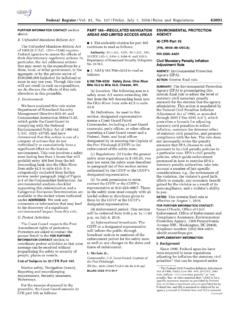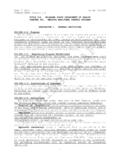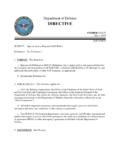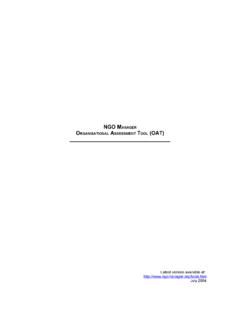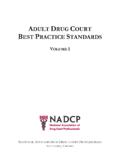Transcription of COMMUNITY HERBAL MONOGRAPH ON …
1 European Medicines Agency Evaluation of Medicines for Human Use 7 Westferry Circus, Canary Wharf, London, E14 4HB, UK Tel. (44-20) 74 18 84 00 Fax (44-20) 75 23 70 51 E-mail: European Medicines Agency, 2009. Reproduction is authorised provided the source is acknowledged London, 12 November 2009 Doc. Ref.: EMA/HMPC/101304/2008 COMMITTEE ON HERBAL MEDICINAL PRODUCTS (HMPC) FINAL COMMUNITY HERBAL MONOGRAPH ON hypericum perforatum L., HERBA (WELL- established MEDICINAL USE) DISCUSSION IN WORKING PARTY ON COMMUNITY monographs AND COMMUNITY LIST (MLWP) March 2008 May 2008 July 2008 September 2008 November 2008 ADOPTION BY HMPC FOR RELEASE FOR CONSULTATION 6 November 2008 END OF CONSULTATION (DEADLINE FOR COMMENTS) 15 February 2009 REDISCUSSION IN WORKING PARTY ON COMMUNITY monographs AND COMMUNITY LIST (MLWP) July 2009 September 2009 November 2009 ADOPTION BY HMPC 12 November 2009 KEYWORDS HERBAL medicinal products; HMPC; COMMUNITY HERBAL monographs ; well- established medicinal use; hypericum perforatum L.
2 ; Hyperici herba; St. John s wort COMMUNITY HERBAL MONOGRAPH ON hypericum perforatum L., HERBA (WELL- established MEDICINAL USE) 1. NAME OF THE MEDICINAL PRODUCT To be specified for the individual finished product. 2. QUALITATIVE AND QUANTITATIVE COMPOSITION1, 2 Well- established use With regard to the marketing authorisation application of Article 10(a) of Directive 2001/83/EC as amended hypericum perforatum L., herba (St. John s Wort) i) HERBAL substance Not applicable ii) HERBAL preparations3 A) Dry extract (DER 3-7:1), extraction solvent methanol (80% v/v) B) Dry extract (DER 3-6:1), extraction solvent ethanol (80% v/v) C) Dry extract (DER :1), extraction solvent ethanol (50-68% v/v)4 Traditional use With regard to the registration application of Article 16d(1) of Directive 2001/83/EC as amended See document EMEA/HMPC/745582/2009 3. PHARMACEUTICAL FORM Well- established use HERBAL preparation in solid dosage forms for oral use.
3 The pharmaceutical form should be described by the European Pharmacopoeia full standard term. Traditional use 4. CLINICAL PARTICULARS Therapeutic indications Well- established use Indication 1 HERBAL preparations A, B: HERBAL medicinal product for the treatment of mild to moderate depressive episodes (according to ICD-10). Traditional use 1 The material complies with the Ph. Eur. MONOGRAPH (ref. 01/2008:1438) 2 The declaraction of the active substance(s) for an individual finished product should be in accordance with the relevant HERBAL quality guidance 3 The HERBAL preparations comply with the Ph. Eur. MONOGRAPH (ref. 07/2008: 1874) 4 A narrow range of the DER to be specified for each product EMEA 2009 2/7 Indication 2 HERBAL preparation C: HERBAL medicinal product for the short term treatment of symptoms in mild depressive disorders.
4 Posology and method of administration Well- established use Posology Adults and elderly HERBAL preparation A: Single dose: 300-600 mg Dosage frequency: 1-3 times daily Daily dose: 600-1800 mg HERBAL preparation B: Single dose: 900 mg Dosage frequency: 1 single daily dose Daily dose: 900 mg HERBAL preparation C: 612 mg, once daily or Single dose: 250-650 mg Dosage frequency: 2-3 times daily Daily dose: 500-1200 mg Children, adolescents The use in children and adolescents under 18 years of age is not recommended (see section Special warnings and precautions for use ). Duration of use Indication 1 The onset of the effect can be expected within 4 weeks of treatment. If the symptoms persist during the use of the medicinal product, a doctor should be consulted. Indication 2 6 weeks. The onset of the effect can be expected within 4 weeks of treatment. If the symptoms persist during the use of the medicinal product, a doctor should be consulted.
5 Method of administration Oral use. Traditional use EMEA 2009 3/7 Contraindications Well- established use Hypersensitivity to the active substance. Concomitant use with cyclosporine, tacrolimus for systemic use, amprenavir, indinavir and other protease inhibitors, irinotecan and warfarin (see section Interactions with other medicinal products and other forms of interaction ). Traditional use Special warnings and precautions for use Well- established use Indications 1 and 2 During the treatment intense UV-exposure should be avoided. Since no sufficient data are available, the use in children and adolescents under 18 years of age is not recommended. Traditional use Interactions with other medicinal products and other forms of interaction Well- established use hypericum dry extract induces the activity of CYP3A4, CYP2C9, CYP2C19 and P-glycoprotein.
6 The concomitant use of cyclosporine, tacrolimus for systemic use, amprenavir, indinavir and other protease inhibitors, irinotecan and warfarin is contraindicated (see section Contraindications ). Special care should be taken in case of concomitant use of all drug substances the metabolism of which is influenced by CYP3A4, CYP2C9, CYP2C19 or P-glycoprotein ( , amitriptyline, fexofenadine, benzodiazepines, methadone, simvastatin, digoxin, finasteride), because a reduction of plasma concentrations is possible. The reduction of plasma concentrations of oral contraceptives may lead to increased intermenstrual bleeding and reduced safety in birth control. Women using oral contraceptives should take additional contraceptive measures.
7 Prior to elective surgery possible interactions with products used during general and regional anaesthesia should be identified. If necessary the HERBAL medicinal product should be discontinued. Traditional use EMEA 2009 4/7 The elevated enzyme activity returns within 1 week after cessation to normal level. hypericum dry extract may contribute to serotonergic effects when combined with antidepressants such as serotonin reuptake inhibitors ( sertraline, paroxetine, nefazodone), buspirone or with triptans. Patients taking other medicines on prescription should consult a doctor or pharmacist before taking hypericum . Pregnancy and lactation Well- established use Animal studies have shown equivocal results. The potential risk for humans is unknown. In the absence of sufficient clinical data, the use during pregnancy and lactation is not recommended.
8 Traditional use Effects on ability to drive and use machines Well- established use No adequate studies on the effect on the ability to drive and use machines have been performed. Traditional use Undesirable effects Well- established use Gastrointestinal disorders, allergic skin reactions, fatigue and restlessness may occur. The frequency is not known. Fair-skinned individuals may react with intensified sunburn-like symptoms under intense sunlight. If other adverse reactions not mentioned above occur, a doctor or a pharmacist should be consulted. Traditional use EMEA 2009 5/7 Overdose Well- established use After the intake of up to g dry extract per day for 2 weeks and additionally 15 g dry extract just before hospitalisation seizures and confusion have been reported. After ingestion of massive overdoses, the patient should be protected from sunlight and other UV-light sources for 1-2 weeks.
9 Traditional use 5. PHARMACOLOGICAL PROPERTIES Pharmacodynamic properties Well- established use Pharmacotherapeutic group: Other antidepressants ATC code: N06AX hypericum dry extract inhibits the synaptosomal uptake of the neurotransmitters noradrenaline, serotonine and dopamine. Subchronic treatment causes a down-regulation of -adrenergic receptors; it changes the behaviour of animals in several antidepressant models ( , forced swimming test) similarly to synthetic antidepressants. Napthodianthrones ( hypericin, pseudohypericin), phloroglucin derivatives ( hyperforin) and flavonoids contribute to the activity. Traditional use Not required as per Article 16c(1)(a)(iii) of Directive 2001/83/EC as amended. Pharmacokinetic properties Well- established use The absorption of hypericin is delayed and starts about 2 hours after administration.
10 The elimination half-life of hypericin is about 20 hours, the mean residence time about 30 hours. Maximum hyperforin levels are reached about 3-4 hours after administration; no accumulation could be detected. Hyperforin and the flavonoid miquelianin can cross the blood-brain-barrier. Hyperforin induces the activity of the metabolic enzymes CYP3A4, CYP2C9, CYP2C19 and PGP dose-dependently via activation of the PXR system. Therefore the elimination of other drug substances may be accelerated, resulting in decreased plasma concentrations. Traditional use Not required as per Article 16c(1)(a)(iii) of Directive 2001/83/EC as amended. EMEA 2009 6/7 EMEA 2009 7/7 Preclinical safety data Well- established use Studies on acute toxicity and repeated dose toxicity did not show signs of toxic effects. The weak positive results of an ethanolic extract in the AMES-test (Salmonella typhimurium TA 98 and TA 100, with and without metabolic activation) could be assigned to quercetin and are irrelevant to human safety.










